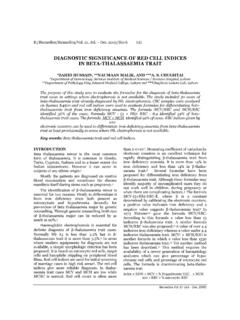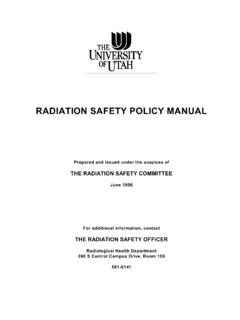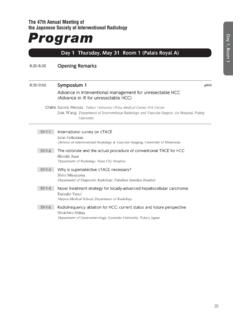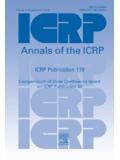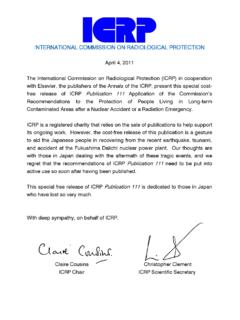Transcription of PNEUMOTHORAX AFTER CT GUIDED …
1 Biomedica Vol. 22 (Jul. - Dec. 2006) F:/Biomedica Jul. Dec. 2006/Bio-3 (B) PNEUMOTHORAX AFTER CT GUIDED transthoracic needle aspiration biopsy OF LUNG MASSES ASIM SHAUKAT, YASSER AMIN, AFSHAN QURESHI, TAHIR Q. KHAN AND M. N. ANJUM Department of Radiology, King Edward Medical College / Mayo Hospital, Lahore The purpose of this study was to analyse the rate of PNEUMOTHORAX AFTER CT GUIDED trans-thoracic needle aspiration biopsy (TNAB) of lung masses, using variable needle sizes. A total of 70 patients underwent this procedure, among them, 18 patients (26%) developed pneu-mothorax, with 18G needles 24 patients underwent FNA and seven of them (25%) developed PNEUMOTHORAX , with 20G needle , 26% developed PNEUMOTHORAX and with the 22G needle 25% developed PNEUMOTHORAX .
2 As a conclusion the study shows that the rate of PNEUMOTHORAX AFTER CT GUIDED TNAB of lung masses remains almost the same regardless of the size of the needle . transthoracic percutaneous biopsy of the lung masses is a long known and time proven invasive procedure. To get to a diagnosis, the clinicians rely heavily on the radiological and pathological findings. Previously days, open biopsy of the lung mass was done to reach a diagnosis but as the medicine is going into newer modalities are there to image the body and guide the invasive radi-ologist, open lung biopsy has become almost obsolete procedure. Computed Tomography (CT) assisted Fine needle aspiration biopsy (FNAB) of the lung masses is now used very frequently in cases where the diagnosis depends on histo-pathology.
3 CT images guide the radiologist to-wards the area of interest and then the procedure is performed. Percutaneous transthoracic needle aspiration biopsy (TNAB) of the lung is a well-established method for obtaining pulmonary tissue for pathological Accuracy for the diagnosis of benign and malignant diseases is greater than 80% and 90%, respectively4-6. Fatal complications due to systemic air embo-lism, haemorrhage, or pericardial tamponade have been described3,7-10, however these complica-tions are rare. Other serious complications, such as seeding of malignant cells into the needle track11, lung torsion12, and empyema(7), also are rare and should not alter indications for TNAB. PNEUMOTHORAX is, by far, the most frequent complication of the procedure: Reported2,8,13-23 rates range widely, from 5% to 61%.
4 Most of these data pertain to fluoroscopically GUIDED TNAB. Overall, TNAB performed with computed tomo-graphic (CT) guidance may be associated with a higher frequency of PNEUMOTHORAX than fluoro-scopically GUIDED TNAB, probably because CT requires more time, and the average size of the lesion is smaller. The reported rate of pneumo-thorax with CT- GUIDED biopsy may also be slightly higher because CT is more sensitive for the detec-tion of PNEUMOTHORAX . The authors of several investigations1,13,24 have reported a 22% 45% risk of PNEUMOTHORAX for CT- GUIDED TNAB. There are multiple factors or variables which affect the rate of PNEUMOTHORAX in CT GUIDED FNAB of chest masses25,26. Size of the needle , size of the lesion, depth of the lesion from the pleural surface and the number of punctures that are given through the pleura are perhaps some of the impor-tant ones which have been studied in quite detail27.
5 Also the time for which the needle remains in the chest cavity, the dwell time and the angle of pleural puncture have been reported25,26 as the factors which have some sort of influence on the development of PNEUMOTHORAX AFTER CT GUIDED FNAB of chest masses. PATIENTS AND METHODS This was a descriptive study. As regard the selec-tion of subjects, the patients having a chest mass and required a biopsy to reach a definitive diag-nosis. A total of 70 patients were selected. They were referred from chest medicine, chest surgery and medical departments. Convenient sampling was done. The study was carried out in the department of Radiology Mayo Hospital, Lahore; and was con-ducted over a period of 10 months from June 2002 to April 2003. PNEUMOTHORAX AFTER CT GUIDED transthoracic needle aspiration 89 Biomedica Vol.
6 22 (Jul. - Dec. 2006) Fig. 1: Marking of the lesion and localization before biopsy . Fig. 2: needle insertion into the lesion close to hila, no PNEUMOTHORAX . Fig. 3: PNEUMOTHORAX during the procedure of TNAB. Inclusion Criteria: 1. Patients between 15 and 75 years of age. 2. The patients had a control X ray chest and CT chest before the FNA was performed. 3. All patients had PT/ APTT done for any ble-eding disorder. Exclusion Criteria: 1. It was because of the complications that could arise from the procedure, only indoor patients were included in the study. 2. Already diagnosed cases were not considered. 3. Patients who were not having proper advice form from the respective consultant also were not considered. Methodology The Fine needle Aspirations (FNA) were carried out under the guidance of CT scan machine of Toshiba Spiral CT Xvision/Ex.
7 The FNA was conducted via 18G, 20G or 22G needles. Size of the lesion, distance of the lesion from the pleura and the number of punctures through the pleura recorded and documented in the form of a proper proforma. Immediate post procedure CT slices of chest and 6 hours delayed Chest X rays were taken to analyze PNEUMOTHORAX . Data Analysis In this descriptive study the data, ; the effect of size of needle , size of lesion, distance of lesion from the pleura and the number of punctures through the pleura on the rate of PNEUMOTHORAX AFTER CT GUIDED FNA of chest masses, were evalu-ated using proportions, frequencies (%). RESULTS Total numbers of patients included in the study were 70, eighteen of these developed pneumo-thorax AFTER the procedure. Table 1: PNEUMOTHORAX and needle size shows the frequency of PNEUMOTHORAX AFTER CT GUIDED TNAB of lung masses in relation to needle size.
8 Sr No. needle Size Total patients done Pneumo-thorax Frequ-ency 1. 18G 24 6 25% 2. 20G 23 6 26% 3. 22G 23 6 26% Total 70 18 90 ASIM SHAUKAT, YASSER AMIN, AFSHAN QURESHI et al Biomedica Vol. 22 (Jul. - Dec. 2006) In a total of 70 patients, 24 underwent FNA through 18G needle , 23 by 20G and 23 by 22G needle . With 18G needle 7 (25%) out of 24 patients developed PNEUMOTHORAX . With 20g needle 6 (26%) out of 23 developed PNEUMOTHORAX and with 22G needle 5 (26%) out of 23 had post procedure PNEUMOTHORAX . DISCUSSION The most common complications of percutaneous transthoracic lung biopsy are PNEUMOTHORAX and bleeding. PNEUMOTHORAX has a broad frequency range of 8 to 64%.27 Bleeding occurs less often (range, 2 to 10%) but is more frequently fatal. Many reports have evaluated the relationship between specific variables and the complications of percutaneous lung biopsy .
9 Complications are evaluated according to variables related to the patient, the lesion, and the biopsy The rate of PNEUMOTHORAX is also dependant on the lung parenchyma the condition of the lung fields. Careful evaluation for Chronic Obstructive Airway disease is an important aspect for this complication. There is a significant rise in the rate of PNEUMOTHORAX if intervention is done in patients with emphysema and other lung cycts, the rate can rise upto 60%.24 The frequency of pneu-mothorax has been studied very extensively using multiple variables, the size of the needle being one. Also the lesion size, depth of the lesion, number of punctures required to obtain adequate samples, the dwell time and the angle of the needle in relation to the pleura have been studied by various Perhaps the most commonly used variable is the needle size.
10 The radiologists who are not aware of the fact that the size of the needle does not influence the rate of PNEUMOTHORAX during the procedure are very reluctant to use the larger bore needle . This has been elaborated by various The present study shows that the rate of PNEUMOTHORAX is independent of the size of the needle bore, three bores were used ; 18G, 20G and 22G, the frequency of pneumo-thorax remained more or less the same during the procedure. All the cases selected were not attached to the pleura and the lesions were of the lungs therefore the pleura had to be punctured. Our study also showed the frequency of PNEUMOTHORAX during the procedure of TNAB 20%. Although it sounds a rather alarming frequency but only one of these 26% patients required a chest tube intu-bation and the remaining resolved at its own.
